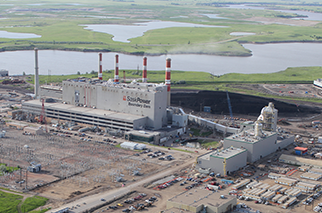Kemp: Carbon Capture's Energy Penalty Problem
SaskPower's Boundary Dam Unit #3, the first utility-scale power plant to be fitted with carbon capture and storage (CCS), has produced a surge in media interest since becoming operational this month.
But it also illustrates the formidable challenges that must be overcome before CCS is ready to play a significant role in the fight against climate change.
Refurbishing the 45-year old Unit #3 to extend its life for another 30 years and retrofitting it with equipment to capture carbon dioxide emissions has cost almost C$1.3 billion, according to the company's accounts, about three times as much as a similar-sized plant without CCS.
SaskPower received $240 million from Canada's government to help with construction costs and will realise additional revenues from the sale of CO2 to an enhanced oil recovery project. But the high capital costs of Unit #3 underscore how far away CCS remains from being competitive with conventional power stations or renewables such as wind and solar.
SaskPower insists that the lessons learned from building the plant and CCS system mean that it could be done much more cheaply next time. But construction cost is not the only problem with the plant.
The refurbished and retrofitted Unit #3 is also much less efficient than its predecessor. It will supply "over 110 megawatts" of electricity to the grid compared with 139 MW previously, a reduction of around 20 percent, according to SaskPower.
The reduction in net output is in line with published estimates for the "energy penalty" imposed by CCS systems, which is the major barrier to their widespread adoption.
Price to Pay
Separating CO2 from the other gases in the plant's exhaust stream (mainly nitrogen and water vapour), compressing it, transporting it by pipeline and injecting it deep underground under high pressure all need a substantial amount of work and consume a significant amount of the heat and electrical output from the power plant.
Published estimates for the size of this "energy penalty" at a typical power plant vary. Researchers at Britain's Imperial College put it at around 20 percent ("Carbon capture technology: future fossil fuel use and mitigating climate change" Nov 2010).
But scientists at Harvard and the Massachusetts Institute of Technology (MIT) suggested the penalty could range anywhere from a theoretical lower bound of 11 percent to as much as 40 percent, with 29 percent as a good target ("The energy penalty of post-combustion CO2 capture and storage" Jan 2009).
The penalty must be paid by burning more fuel or reducing the net amount of electricity supplied. In Unit #3's case, the project planners opted for lower net electrical output.
Net output from Unit #3 has fallen around 20 percent, but the upgrade is likely to have involved an improved steam generator and turbines, which would otherwise have increased output.
The underlying energy penalty probably falls within the 20-30 percent range, in line with the central estimates produced by most researchers.
Policy Support
The most modern ultra-supercritical coal power plants can achieve a thermal efficiency of up to about 45 percent.
Retrofitting an ultra-supercritical power plant would reduce its thermal efficiency to around 35 percent, a penalty of around 25 percent.
But for less-efficient supercritical and sub-critical power plants, with initial thermal efficiencies of less than 40 percent and in some cases less than 30 percent, the penalty could amount to 40 percent or even 50 percent of the plant's total electrical output.
Even a 20-30 percent energy penalty is enormous and would radically affect the operations of coal-fired power plants in North America and the rest of the world if all power plants were retrofitted with CCS systems.
Retrofitting all coal-fired plants in the United States would increase coal consumption by 400-600 million tonnes per year, or cut their net electrical output by 75-100 gigawatts, more than the peak demand of California, according to the Harvard and MIT researchers.
In practice, it would not be cost-effective to retrofit the entire fleet. It would make more sense to retrofit only the most modern and efficient plants, retire older ones and replace them with new capacity.
Given the enormous practical impact of the energy penalty, there is intense interest in finding ways to reduce it.
Most of the energy consumed in the CCS process is used in capturing and compressing CO2 in the first place.
Researchers are trying to find ways to separate CO2 more efficiently from the other gases in the exhaust stream and run the compression system using some of the heat that would otherwise be wasted from the power plant.
But even with those measures, CCS will only be competitive if the energy penalty is offset by carbon taxes, carbon prices, or other policy measures to level the playing field by pushing up the cost of electricity from other fossil fuel plants.
So in the longer term, the outlook for CCS is really a gamble on the outlook for carbon prices, taxes and tough emission controls, rather than a technology problem.
By John Kemp








